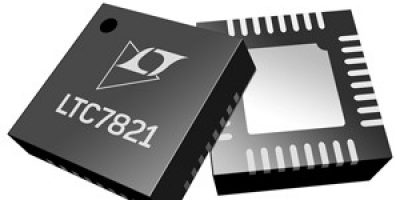Hybrid step-down DC/DC controller shrinks form factor by half
Claimed to be an industry first, the LTC7821 is a hybrid step-down synchronous controller from Analog Devices. The Power by Linear controller merges a switched capacitor circuit with a synchronous step-down controller, enabling up to a 50 per cent reduction in DC/DC converter size compared to traditional step-down device, says ADI.
This improvement is enabled by a three-fold higher switching frequency without compromising efficiency, adds the company. Alternatively, when operating at the same frequency, an LTC7821-based solution can provide up to a three per cent higher efficiency. Other benefits include low EMI and reduced MOSFET stress, due to a soft-switched front end. These characteristics make the LTC7821 particularly suitable for non-isolated intermediate bus applications in power distribution, datacomms and telecomms as well as emerging 48V automotive systems.
The LTC7821 operates over a 10 to 72V (80V max) input voltage range and can produce an output voltage from 0.9 to 33.5V with currents in multiple 10s of A, depending on the choice of external components. In a typical 48 to 12V/20A application, an efficiency of 97 per cent is attainable with the LTC7821 switching at 500kHz. The same efficiency can only be achieved in a traditional synchronous step-down converter by switching at one-third the operating frequency, resulting in the use of much larger magnetics and output filter components, says ADI.
External MOSFETs switch at a fixed frequency programmable from 200kHz to 1.5MHz. The LTC7821’s one-Ohm n-channel MOSFET gate drivers maximise efficiency and can drive multiple MOSFETs in parallel for higher power applications. Due to its current mode control architecture, multiple LTC7821s can be operated in a parallel, multi-phase configuration with current sharing to enable much higher power applications, advises ADI.
The LTC7821 implements proprietary protection features. For example, an LTC7821-based design eliminates the inrush current typically associated with switched capacitor circuits by pre-balancing the capacitors during start-up. The LTC7821 also monitors system voltage, current and temperature for faults, and uses a sense resistor for overcurrent protection. It stops switching and pulls the /fault pin low when a fault condition occurs. An on-board timer can be set for appropriate restart/retry times. The EXTVCC pin enables the LTC7821 to be powered from the lower voltage output of the converter or other available source up to 40V, reducing power dissipation and improving efficiency. Additional features include ± one per cent output voltage accuracy over temperature, a clock output for multiphase operation, a power good output signal, short-circuit protection, monotonic output voltage start-up, optional external reference, under-voltage lockout and internal charge balance circuitry.




